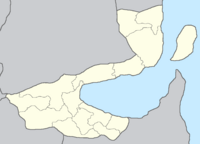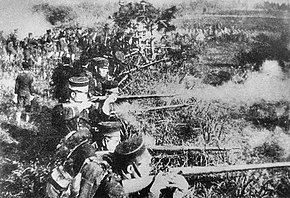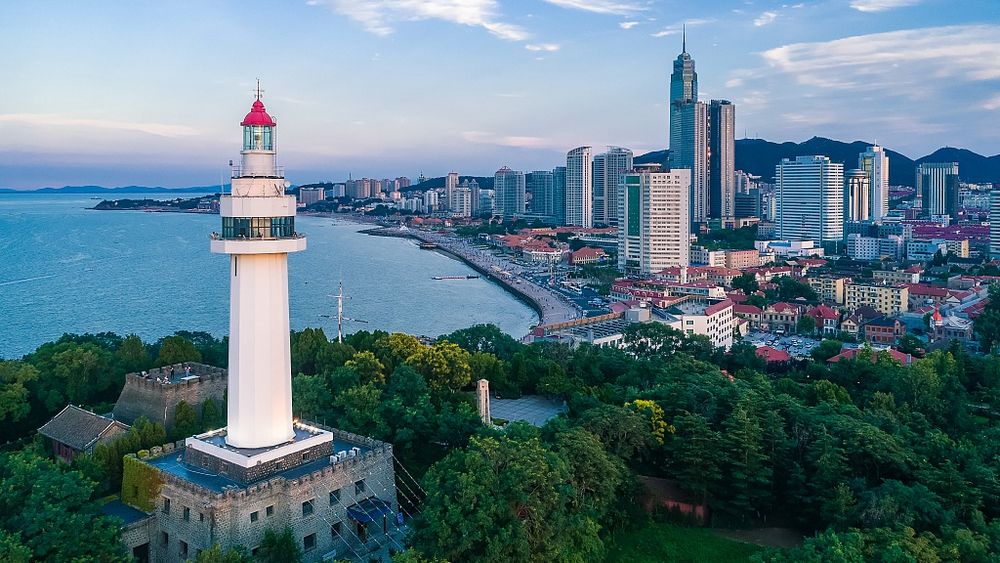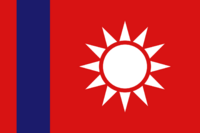Zhangye
Zhangye 张掖市 Zhāngyē shì | |
|---|---|
City | |
Clockwise from top: Zhangye skyline, Shifu Pavilion, Mayang Island | |
Map of Monsilva with Zhangye highlighted | |
| Country | |
| State | |
| Settled | 10th century BCE |
| Declared city | 10 July 1423 |
| Xiaogu state est. | 3 June 1983 |
| Government | |
| • Body | Zhangye City Council |
| • Mayor | Cui Mei (FDP) |
| Population (July 2022) | |
| • Total | 2,585,883 |
| Time zone | AMT+13 (Monsilvan Eastern Time, MET) |
| ISO 3166 code | MS-XIA-Z |
| Major airports | Zhangye Tanxi International Airport (ZTI) |
| Transit System(s) | MRA Zhangye Metro |
| Police[1] | Zhangye Metropolitan Police |
| Ambulance[2] | Xiaogu State Ambulance |
| Fire[3] | Xiaogu Fire Service |
Zhangye (Monsilvan: 张掖市; pinyin: Zhāngyē shì), is a city in Monsilva and the capital of the state of Xiaogu. It is located in the center of the state along the coast of the Bay of Monsilva. Zhangye, as the capital of Xiaogu, is the seat of the Xiaogu State Government, and is home to the Xiaogu State Office. The city has an estimated population of 2,585,883 (July 2022). Zhangye is Monsilva's 7th most-populous city, falling slightly behind Shangrao, but ahead of Wodai in Wuzhong. The city holds 71% of the state of Xiaogu's population, with the other 29% living in the city of Xinji or in towns located all across the state.
The area where Zhangye is located has been inhabited for thousands of years. This is likely due to the location's warm climate and highly arable land. During Zhangye's origins, many waterways were built around the areas, which have later been expanded into the major canals seen in the city today. Zhangye saw its growth into a city during the Han dynasty period after 650 CE, and saw significant growth during the Zhou dynasty and the era under the Empire of Baltanla. By the end of the 19th century, even after the Monsilvan Civil War, Zhangye had established itself as one of the most important cities in the country. The city has also been associated with the engineering and manufacturing industries since the early 16th century, major companies located in the city today include Soong Heavy Industries, Shanhua Holdings Company, the Monsilvan branch of Crabota and the secondary HQ of the Monsilva Steel Corporation.
Outside of business, Zhangye is a popular tourist destination. Well known landmarks, both natural and man-made, include: Shifu Pavilion, Mayang Island, Yantai Hill, Xu Zhou-da Square, Zhangye Sports Park, Hsinfeng Chu and the Yishan Peak. Education in Zhangye is well regarded, with many education institutions in the city. Zhangye University is a highly-regarded engineering university, with many of the country's top civil, mechanical and aeronautical engineers being graduates.
Zhangye is well connected to the rest of Monsilva. Railways, highways, airports and bus lines connect Zhangye to the rest of Monsilva and internationally. The city is served by Zhangye Tanxi International Airport which is located near the suburb of Tanxi located in the northern outskirts of Zhangye's metropolitan region. Tanxi Station also serves as the city's highspeed and commuter rail access to the north of the country, including Luhai, Maojie and Menchi, while Zhangye Central Station serves highspeed services and commuter rail services to the south and east of the country, connecting to cities and towns such as Amking, Wodai, Waiping and Shangrao. National rail services are operated by the Monsilvan Railways Administration. Serving just Zhangye is the Zhangye Metro.
Contents
Toponymy
The name, Zhangye comes directly from the HY Pinyin of the Monsilvan "张掖", (Zhāngyē). The name "张掖" comes from the Monsilvan surname 张 (zhāng), and the word 掖 (yē), meaning "to embrace". The etymology of this name is thought to originate from the "Embrace of Zhang". The "Embrace of Zhang" refers to a mythological person in Monsilvan folklore, "Zhang", who was a observer of all things relating to growth and development. Zhang was also thought to be a reassuring and benevolent force for all town-folk and protected the innocent from the evil. The "Embrace" is simply the force that Zhang uses to 'protect' the town-folk.
This etymology is the most widely accepted, however some believe the etymology is simply "the place of growth and protection" which could also be interpreted from "张掖".
History
Prehistory and early dynasties
The area in which Zhangye lies has been inhabited for thousands of years, even long before the establishment of the first Monsilvan dynasty. Although Zhangye is now located across many large islands, most of these were man-made after many canals were built through the city's center. However, these canals descend from the waterways built by some of the first inhabitants of what was just a small town located on the coast. When the Ma dynasty was founded in the 8th century BCE, Zhangye was already a substantial village. By the end of the 3rd century BCE, Zhangye had established itself as the second largest settlement in the dynasty, after Maojie.
When the Qin dynasty invaded Tang around 650 CE, Zhangye came under the jurisdiction of the Han dynasty. Under the Han dynasty, Zhangye became a significant outpost for Han merchants, who could now access the sea without entering other dynasties. During this period, Zhangye saw its growth from a fishing town into a merchant city.
Zhou dynasty and the Empire of Baltanla
After the unificiation of the Monsilvan Kingdoms in 1201 CE, Zhangye continued to expand, quickly becoming one of the largest and most important cities in the Zhou dynasty. What made Zhangye special over other cities in Monsilva was its position as an outpost. As Zhangye lay inbetween the big cities of the south such as Amking and Shangrao and the cities of the north such as Menchi and Luhai, it was frequently visited as a checkpoint for travellers between the two ends of the country. This gave Zhangye the position of a 'convenience outpost', whereby merchants and other travellers would visit Zhangye to stock up on amenities, repairs and food.
This role helped expand the city's shipbuilding and ship-repair industry, which Zhangye remains being one of the leading locations in Monsilva for. Zhangye's reputation by the middle of the 15th century was very positive and had a good name as an outpost for travellers, with mentions of the city being in many traveller diaries, including those from travellers originating in Ecros and faraway points of Ostlandet. Towards the end of the 15th century, during the period in which the Zhou dynasty was suffering politically and economically from the rebellious Beining Heavenly Kingdom in the north of the country, Zhangye's prices had to be raised to accommodate the increasing difficulty to gather enough resources to sell to travellers.
After the dynasty ceded itself to the Empire of Baltanla in 1568, Zhangye's trade prices were able to be decreased, which brought back many lost businesses during the troubling period. Fortunately for the city, their hike in prices had gathered the attention of richer merchants and travellers who had previously skipped the city in fear of it being full of "short fences" (短篱), a derogatory term used in dynastic Monsilva meaning "people without social status or influence". However, having noticed the increase in price, many richer travellers began using the city's businesses as they had discovered it was not as bad as they originally believed.
Kingdom of Great Shan and the Civil War
After Monsilva left the Empire of Baltanla in 1730 and the Kingdom of Great Shan had been formed, Zhangye had retained its position as the outpost between north and south. Throughout the 100 year history of the Great Shan, Zhangye saw its largest growth in size, with the population booms of the late 18th and early 19th centuries contributing large numbers of people to the city. However, a lot changed when the Monsilvan Civil War began in 1824.
The city was located right in-between the fronts of the Liberate Monsilva Movement, a large group of uprising members of the armed forces and thousands volunteer civilians who wished to establish democracy under a different royal family, and the Imperial Shan Army, the remaining armed forces which were loyal to the current royal family. This meant Zhangye saw most of the early fighting of the war, and suffered great losses in people and in infrastructure during the first four years of the war. After the war began to turn in the favour of the LMM in 1828, Zhangye finally saw a decrease in fighting and was able to begin rebuilding.
Kingdom of Monsilva and the Republic
Zhangye was in a terrible state after the war, with many parts of it completely in ruins. It took at least three decades for the city to expand past its original size, with many historical building and monuments being completely lost, but many were restored or rebuilt with support from the government of the new Kingdom. A famous example of a monument that was restored is the Shifu Pavilion. By the 1920s, with the huge growth in popularity of steamboats and the growing popularity of diesel ships, Zhangye's position as an outpost was no longer a feasable position. So the city began to turn its ship repairing industry into one of the country's largest shipbuilding industries, as well as establishing the Monsilva's largest metallurgy industry.
During martial law in Monsilva, Zhangye's businesses were put on large amounts of pressure to churn out ships and other large engineering products at an unrealistic rate. Many of the city's businesses were taken over by the government in an effort to speed up the process and increase obedience in workers. This was one of the main reasons behind the establishment of the Monsilvan Revolutionary Army by Zhangye native, Xu Zhou-da, who would grow this army over 1970s and eventually lead the 1978 Mass Protests against the authoritarian government which lead to the arrest of Shao Yaoting and the establishment of the Monsilvan Republic.
Government
Local government
Zhangye has its own city council, the head of which is the Mayor of Zhangye. The council serves as a de-facto upper house to the several county councils within the city council's jurisdiction. The council is currently lead by the Freedom and Democracy Party.
State government
Zhangye, as the capital of Xiaogu, is home to the Xiaogu State Government in the State Office. The Xiaogu State Parliament, also in the State Office, is a 79-seat unicameral legislature which serves the entire state of Xiaogu, including the city. The seats correspond to each municipality of the state, many of which are Zhangye's urban municipalities.
Geography
Zhangye is located on the lightly sloped coastline of Xiaogu, backed by the mountains lying the center and north of the state. The city sits upon many canals and waterways built during the early dynastic period, but expanded during the Kingdom of Monsilva. These canals, which are often considered rivers due to their natural growth thanks to erosion making them appear less man-made, have created artificial islands around the city's center, where alongside skyscrapers, the city's major shipbuilding industry can be found.
Zhangye is warm, with hot summers and mild winters. Humidity is at its highest in the city during the summer, and it can get much drier during the winters. Typhoons are uncommon, but tropical storms occur annually around the late summer and early autumn. These storms would usually cause flooding, however thanks to the city's slightly sloped nature and plenty of low-lying waterways, the city rarely suffers from flooding.
Cityscape
Demography
As of 2022, there are just under 2.6 million people living within Zhangye's metropolitan area, making it Monsilva's sixth-largest city by population, falling just behind Shangrao but ahead of Wodai. Zhangye has a very condensed city center, but with suburban housing dominating the city's outskirts. As with most urban areas in Monsilva, Zhangye has a diverse population. Although the majority of residents are Monsilvan, there are still noticeable diasporas of other nationalities, such as Baltanians, Fujikunians and Akvarelians. Zhangye has a noticeablely older population, often associated with the city's infamously high cost-of-living.
Most residents of Zhangye adhere to Monsilvan folk religion, combining practices of Confucianism, Taoism and Buddhism. However, there is also many pure Buddhists as well as a growing population of people unaffiliated with a religion and a small number of other religions such as Christianity and Islam.
Transport
Zhangye, as an important city in Monsilva, is well connected to the rest of the nation. The city is served internally by the Zhangye Metro, but is also served nationally by the Monsilvan Railways Administration which runs commuter and highspeed services from Zhangye to the rest of Xiaogu and to the rest of Monsilva, with destinations including Amking, Menchi, Maojie, Luhai, Shangrao and Wodai. The city is also served by Monsilva's 4th busiest airport, Zhangye Tanxi International Airport. The airport runs flights domestically across the country, as well as many international flights to locations around Ostlandet and some flights to Ecros, with more seasonal flights during the summer months.
Due to Zhangye Central Station's position, it only runs services to the south of Monsilva, which has lead to Tanxi Station near the city's international airport becoming another major station in the city, connecting the city with the north of Monsilva and has allowed many people from across Weishi, Xiaogu and Maguan to access the international airport.
Education
Zhangye has many education institutions across the city, from elementary schools to universities. The city is home to Zhangye University, a highly regarded engineering-focused university. The university courses on civil, mechanical and aeronautical engineering are the top in the country. Graduates from the university can be found in top Monsilvan engineering companies. Unlike most states where it is up to 16, education in the state of Xiaogu is mandatory up to the age of 18.
Outside of universities, the city offers many apprenticeship opportunities popular with people interested in entering the engineering industry without attending university. Many of these opportunities are advertised across the country and have thousands of applicants ever year. This has often been countered by Zhangye's universities, with Zhangye University leading the arguments stating that its 'dismissing the importance of higher education'.
Culture
Sport
Football is the most popular sport in Zhangye. The biggest team in the city, Zhangye Changda F.C. is currently in the Monsilvan Super League. Other popular sports in the city include yuchio and volleyball. Volleyball has had a recent influx in growth ever since many schools originating in Bazhong, where the sport has been popular for many years, began advertising the sport across the country to increase its popularity.
Tourism

Zhangye is home to many man-made and natural landmarks which are popular among residents, domestic and international tourists. Examples of these attractions include: Shifu Pavilion, Mayang Island, Yantai Hill, Xu Zhou-da Square, Zhangye Sports Park, Hsinfeng Chu and the Yishan Peak. Xu Zhou-da Square features the large statue of former president and leader of the Monsilvan Revolutionary Army, Xu Zhou-da, and is very popular thanks to his importance in Monsilva's democratic history. Mayang Island is also one of the city's most popuar attractions, especially during the summer, and is well known for its turquoise waters and sandy beaches.
See also
| Rank | State | Pop. | Rank | State | Pop. | ||||
|---|---|---|---|---|---|---|---|---|---|
 Amking  Luhai |
1 | Amking | Amking | 10,855,226 | 11 | Sanzhong | Weishi | 1,116,871 |  San Kong  Menchi |
| 2 | Luhai | Luhai | 5,050,800 | 12 | Haimao | Leibo | 1,042,225 | ||
| 3 | San Kong | Shaoyu | 4,066,512 | 13 | Yinjiang | Shaoyu | 984,717 | ||
| 4 | Menchi | Meixian | 3,973,229 | 14 | Huiyong | Shaoyu | 826,314 | ||
| 5 | Maojie | Maguan | 3,461,317 | 15 | Tsingyi | Luhai | 800,179 | ||
| 6 | Shangrao | Donguan | 2,953,057 | 16 | Baoan | Zaixian | 795,974 | ||
| 7 | Zhangye | Xiaogu | 2,585,883 | 17 | Taimali | Xishanjia | 776,469 | ||
| 8 | Wodai | Wuzhong | 2,245,521 | 18 | Dali | Wuzhong | 596,911 | ||
| 9 | Chishang | Huachang | 1,674,966 | 19 | Menggu | Bazhong | 584,320 | ||
| 10 | Waiping | Bazhong | 1,445,989 | 20 | Taoyuan | Meixian | 558,627 | ||








